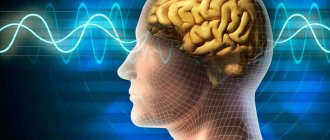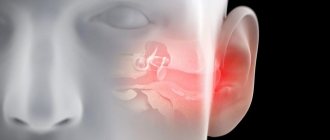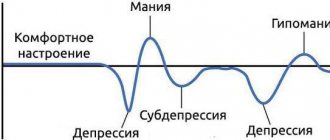Pulmonary hyperventilation syndrome can be either a controlled or uncontrolled process, characterized by intense, fast and deep breathing.
This condition leads to an imbalance between carbon dioxide and oxygen, which can lead to serious complications. Our article will tell you what hyperventilation is, what are its causes, symptoms, and how it is treated.
- Drug treatment
- ethnoscience
- How to help yourself during an attack?
General information
Hyperventilation syndrome is one of the types of disorders of the autonomic nervous system, which is manifested by difficulty breathing.
The pathology is quite common and is diagnosed in approximately 15% of the population. Hyperventilation syndrome is in no way associated with diseases of the pulmonary system, bronchi or heart. The feeling of lack of air occurs solely against the background of disruption of the autonomic nervous system , which is responsible for the vital processes of the body that are beyond the control of our consciousness.
A person can control the frequency and depth of breathing only for a certain time. Breathing can be deep and shallow, rare and frequent, with or without delay.
The pathology occurs in people of various age groups, but the peak incidence is recorded in people 30-40 years old. Females among patients are 4-5 times more common than males. The syndrome is characterized by a predominantly chronic course, with acute cases accounting for only 2% of calls.
Prevention of hyperventilation
A healthy person who experiences hyperventilation syndrome at least occasionally should have their lungs checked and examined by doctors. It has been proven that 25% of these people have undiagnosed conditions that lead to this syndrome. The cause of this pathological condition may be latent bronchial asthma, the presence of which a person does not know.
To determine if you have hyperventilation syndrome, you can do a test yourself. You need to take 10 deep exhalations and deep breaths to work the muscles. If you feel dizzy, a person is susceptible to this pathological condition.
Hyperventilation is effectively treated and can be easily prevented.
Pathogenesis
The psycho-emotional state of a person quite strongly influences the functioning of the respiratory system. Various psychogenic triggers (for example, anxiety) lead to biochemical shifts that affect the balance of calcium and magnesium. The development of hyperventilation is potentiated by changes in the functioning of respiratory enzymes.
Due to excessive release of carbon dioxide, its concentration in the blood decreases, which leads to a shift in pH to the alkaline side, hypocapnia and the development of respiratory alkalosis . Against the background of the changes described above, specific symptoms appear:
- tetany;
- algic disorders;
- disturbances of consciousness;
- autonomic and sensory disorders.
The result is increased anxiety, which supports hyperventilation. Even after eliminating the provoking etiological factor, the vicious circle continues to exist and negatively affect the patient’s health.
Diagnostic and therapeutic measures
Treatment of the disease should begin with diagnosis. First you need to examine the patient, collect complaints and study the anamnesis. Additionally, the patient is recommended to visit a psychologist. Supporting activities include:
- capnography;
- blood analysis;
- spirometry.
This video talks about hyperventilation syndrome:
Capnography is the main technique that can be used to select the optimal treatment. Using this diagnostic, the percentage of carbon dioxide in the air is determined. Along with this procedure, blood is studied. The technique is widely used to determine brain hypoxia.
Spirometry is a way to detect lung expansion. Thanks to the technique, it is possible to assess the air permeability in the respiratory tract. Additional methods include ultrasound, brain tomography and other methods, depending on the patient’s complaints.
Treatment can be causal or symptomatic. First, it is necessary to influence the main factor that caused the problem to develop. Then they move on to eliminating additional symptoms, which can significantly improve the person’s condition.
This video talks about treating hyperventilation:
The main treatment methods include visiting a psychotherapist, using sedatives, physiotherapeutic measures, sedatives and beta blockers, which normalize the activity of the nervous system. Treatment must be comprehensive.
The function of respiration is to carry out gas exchange between the alveolar lungs and the external environment. The composition of air fluctuates within a narrow and constant range. When you hyperventilate, oxygen levels rise and carbon dioxide levels fall. A decrease in the level of carbon dioxide in the blood - hypocapnia - shifts the pH value to the alkaline side and changes the activity of vitamins and enzymes. As a protective compensatory mechanism that prevents further loss of CO2, spasms of blood vessels and bronchi occur, blood pressure decreases, and cholesterol production in the liver increases.
Spasmed blood vessels and bronchi make it difficult for oxygen to reach the cells of the brain, heart and other organs. A decrease in the concentration of carbon dioxide in the blood increases the strength of the bond between oxygen and hemoglobin; hemoglobin does not release oxygen to the tissues, and this leads to hypoxia. The body begins to suffer from oxygen deficiency.
Classification
Pathological types of breathing:
- terminal;
- periodic;
- dissociated.
Types of periodic breathing:
- Biota;
- Cheyne-Stokes;
- wavy.
Periodic breathing is characterized by alternation of respiratory movements and pauses in the form of apnea . The pathology occurs against the background of a disorder of the automatic respiratory control system.
Terminal breathing types include:
- gasping breath;
- apnestic breathing;
- Kussmaul's breath.
Pathological terminal types of breathing are accompanied by gross disturbances of rhythmogenesis. Kussmaul breathing is characterized by a deep inhalation followed by an extended, forced exhalation. Kussmaul is described as deep and noisy breathing, which is recorded in unconscious patients due to uremic, diabetic or hepatic coma. Kussmaul breathing is triggered due to a pathology of excitability of the respiratory center in individuals with cerebral hypoxia , metabolic acidosis and toxic phenomena .
Dissociated breathing is characterized by:
- asymmetry of the right and left halves of the chest;
- paradoxical movements of the diaphragm.
Da Costa syndrome is named after the monk and is manifested by a paroxysmal increase in pulmonary ventilation, which is accompanied by changes in consciousness, pain, sensitivity, muscle-tonic and autonomic disorders. Da Costa syndrome occurs after psychological trauma in the form of acute and chronic stress.
Diagnosis of respiratory tract neurosis
The difficulty in diagnosing respiratory neurosis lies in the fact that the clinical manifestations of the disease are similar to the symptoms of many pathologies. For this reason, the process of differential diagnosis can be lengthy. To confirm the diagnosis, doctors prescribe capnography. This is a test that measures the concentration of carbon dioxide that a patient emits. In order to provoke the onset of an attack, the doctor asks the patient to breathe as often as possible, then records the research data.
Diagnosis of respiratory tract neurosis is carried out using the Nymigen Questionnaire. This is a test developed by Dutch pulmonologists. The patient is asked to answer 16 questions. Based on the results, the doctor assesses the degree of progression of respiratory neurosis.
Causes
Hyperventilation syndrome occurs due to the combination of the respiratory regulation system. During periods of stress, or when the patient is overtired or afraid, the depth and rhythm of breathing movements changes involuntarily, which leads to a feeling of lack of air. This is what provokes panic attacks , which further aggravate the course of hyperventilation syndrome.
Also, increased suspiciousness or the patient’s exposure to outside influences can lead to pathological breathing. For example, an attack of suffocation may occur after a person has seen an attack of bronchial asthma in another patient. This event can be recorded in memory and even after a few years lead to the formation of hyperventilation syndrome.
Etiological factors:
- Organic. These include various lesions of the central nervous system (dyscirculatory encephalopathy , hydrocephalus , arachnoiditis ), as well as diseases of internal organs (recurrent bronchitis , arterial hypertension , diabetes mellitus ). The influence of only organic factors occurs in 5% of patients with hyperventilation syndrome.
- Psychogenic. They are provoked by mental disorders ( neurasthenia , depression , anxiety or phobic disorders, and extremely rarely – hysterical neurosis ). Pathology can develop against the background of acute and chronic stressful situations. In some cases, the syndrome develops as a result of psychogenic behavior in childhood, when the child witnessed an episode of suffocation of a drowning person or asphyxia .
- Mixed. In these cases, the psychogenic trigger is triggered in response to organic pathology. Occurs in 35% of cases.
Hyperventilation syndrome can also be triggered by taking certain medications (methyl xanthine derivatives, salicylates, beta-agonists, progesterone ).
Causes of breathing problems
Hyperventilation of the lungs usually affects everyone who is exposed to neurotic reactions. According to statistics, more than 10% of all women are familiar with the problem. The inability to calmly react to troubles in women usually causes a stress reaction, which provokes the release of adrenaline. And this hormone has a direct effect on the functioning of the heart and lungs, increasing breathing and heart rate. In addition, the causes of hyperventilation may be:
- panic attacks;
- hysterics;
- neurasthenia;
- fright;
- high level of anxiety;
- excessive physical activity;
- asthmatic attack;
- alcohol and other intoxication;
- heart failure.
Sometimes hyperventilation occurs in women in labor, especially for first-time mothers who, due to lack of experience or as a result of excessive efforts, breathe too quickly during contractions. The first labor lasts, as a rule, up to 24 hours; if the woman in labor tries to breathe deeply and frequently during this entire time, hyperventilation increases.
Symptoms of hyperventilation syndrome
The disease is characterized by polymorphism and a multiplicity of symptoms. However, it is customary to distinguish a typical triad in the clinical picture of HVS:
- emotional disturbances;
- respiratory dysfunction;
- muscle-tonic phenomena.
There are 4 forms of breathing disorder:
- Empty breath is a subjective feeling of lack of air, which encourages the patient to breathe more often and deeper.
- Labored breathing. Patients describe the condition as “a lump in the throat”, “stiffness when inhaling.” It takes some effort to take a full breath. Accessory muscles take part in the act of breathing, and arrhythmic increased breathing is recorded.
- Respiratory automaticity disorder. It seems to the patient that breathing stops, which encourages him to independently control the breathing process and correct it.
- The use of hyperventilation equivalents (coughing, yawning, deep sighs, sniffling).
Psycho-emotional disorders are manifested by feelings of fear and anxiety. The most commonly reported disorder is generalized anxiety disorder . Patients complain of loss of the ability to relax on their own, note increased anxiety and constant nervous tension. Quite often, fear of public places (social phobia) and open spaces (agoraphobia), aggravated by respiratory disorders, is detected.
Muscular-tonic syndrome develops due to changes in the electrolyte composition of the blood, which is responsible for neuromuscular excitability. Patients complain of " paresthesia ", which is manifested by burning, numbness, tingling and a crawling sensation. Tetanic phenomena also appear in the form of muscle spasms and tonic convulsions in the distal limbs. Carpopedal spasm is extremely rarely recorded.
Classic symptoms of hyperventilation:
- cardialgia;
- headache;
- pain in the epigastric region;
- dyspepsia;
- confusion;
- cardiopalmus;
- syncope.
Symptoms
Hyperventilation syndrome is a disease that occurs in crises. The symptoms of the syndrome appear quite unexpectedly and very powerfully, while the symptoms after a certain period of time cease to bother you until the next attack. As a rule, symptoms bother patients from several minutes to 1-2 hours.
A hyperventilation crisis begins with fear and unreasonable anxiety, which are simultaneously accompanied by a feeling of lack of air, a lump in the throat, the inability to take a full breath, and shortness of breath. These symptoms can appear simultaneously with fear and anxiety, or come with a slight delay. As a rule, symptoms progress and patients are overcome by a new fear - the fear of death. Next, disturbances occur in the cardiovascular system, such as high blood pressure, rapid pulse, chest pain, and so on. Fear gradually develops into panic. Often other symptoms appear, which can be divided into 5 groups:
- Autonomic symptoms are manifested by urinary disorders, cardiovascular, respiratory and gastrointestinal disorders;
- Motor and muscle-tonic disorders;
- Clouding of consciousness;
- Mental disorders;
- Sensory organ disturbances, pain.
Let's consider each identified group of symptoms separately.
Urinary disorders
As a rule, this disorder worries patients closer to the end of the crisis. Patients produce a large amount of urine, urinate frequently, and the color of the urine becomes light, close to transparent.
Cardiovascular disorders
During hyperventilation crises, disturbances in the cardiovascular system occur quite often. Their list includes:
- Chest compression, pain;
- Feeling every heartbeat;
- Stitching, aching, squeezing or shooting pain in the heart;
- Heart rhythm disturbances;
- Pressure surges;
- Feeling of discomfort in the heart area;
- Raynaud's syndrome;
- Excessive sweating;
- Blue discoloration of feet and hands;
- Hearing impairment, noises in the head;
- Headache;
- Changes in ECG;
- Unsteady gait;
- Dizziness.
Respiratory disorders
Respiratory disorders are an obligatory “guest” during a hyperventilation crisis. Violations along this line have the following symptoms:
- Lack of air;
- Feeling of empty breath;
- Excessive concentration on the breathing process.
Patients often complain that they want to take as deep a breath as possible, but no matter how hard they try, this is not possible. As a rule, such patients during a crisis have a normal rhythm of exhalation and inhalation, and the breathing itself is deep and rapid. The reason for dissatisfaction with your breathing in this case is a crisis stressful situation, in which all sensations intensify significantly.
Patients often complain that they simply cannot stop making efforts to take each breath: it seems to them that if they stop their efforts, they will stop breathing altogether.
When patients cannot take a full breath due to the presence of obstacles such as a tight chest or a lump in the throat, they prefer to concentrate all their attention on what is preventing full breathing. Patients try to cope with the “obstacle”, finding the cause of difficulty breathing solely in themselves. As a rule, such patients breathe extremely quickly, making enormous efforts for each inhalation and exhalation with muscle tension, which do not take part during quiet breathing. Breathing becomes frequent and unrhythmic. In some ways, these symptoms of a hyperventilation crisis resemble the symptoms of asthma.
Frequent symptoms are sniffling, yawning, coughing and sighing, repeated frequently and, again, for no reason. They usually do not cause discomfort or fear in patients, but they affect the gas composition of the blood and disrupt its acidity. These symptoms are not relevant for the crisis state of hyperventilation syndrome.
Gastrointestinal disorders
In the vast majority of cases, hyperventilation syndrome is accompanied by disturbances in the functioning of the gastrointestinal tract. The list of symptoms includes:
- Vomit;
- Rumbling in the stomach;
- Bloating;
- Belching;
- Constipation or diarrhea.
- Abdominal pain;
- Intolerance to foods that were previously digested normally.
Motor and musculo-tonic disorders
In 9 out of 10 cases, hypertensive crises are accompanied by these disorders, which are represented by the following disorders:
- Trembling in the arms and legs, most often with a feeling of cold or heat;
- Chvostek's sign (excessive readiness of muscles to contract);
- Carpopedal spasm (the foot bends, the fingers are folded in such a way as if the patient were taking a pinch of salt).
Changes in consciousness
Symptoms of changes in consciousness include the following:
- Mild blindness, blurriness, fog in the eyes, darkening;
- Presyncope;
- Fainting;
- The feeling that familiar events never happened and, conversely, events unknown to the patient are allegedly repeated;
- Loss of personality, expressed in the patient’s thoughts regarding his reincarnation (depersonalization);
- Loss of reality, expressed in the feeling of being in an unreal world: a film, a fairy tale, and so on (derealization).
Mental disorders
At the time of a hyperventilation crisis, the mental state of patients deteriorates significantly, but it does not indicate insanity and does not cause inappropriate behavior. Mental disorders are manifested by the patient's current thoughts and experiences. Symptoms along this line include:
- Sadness;
- Yearning;
- Fears;
- Anxiety;
- Unreasonable worries;
- An overreaction to any situation.
Sensory organ disturbances, pain
Hyperventilation syndrome in a state of crisis always leads to pain and causes sensory disturbances. Symptoms along this line are extremely varied. The most popular symptoms are:
- Burning, tingling, sensation of “goosebumps”;
- Numbness of the limbs and parts of the body (usually the hands and face, the rest - less often);
- Feelings of advancing paralysis;
- Distinct pain in the head, stomach, heart and other parts of the body and organs;
- Pain with every convulsive contraction of the muscles.
Tests and diagnostics
In addition to instrumental diagnostic methods, the most important components when examining a patient are a thorough examination and a detailed history taking. Hyperventilation syndrome is always accompanied by a huge number of complaints about the functioning of organs and systems. The final diagnosis can be made only after the examinations show the absence of organic pathology. It is for this purpose that patients are prescribed spirography, echocardiography, ECG, and ultrasound examination of the abdominal organs.
When you first interview a patient, you can easily identify high emotional tension or a certain amount of anxiety. If a positive result is obtained from a psychogenic test, the doctor may immediately suspect hyperventilation syndrome.
Also, to identify pathology, the patient is recommended to breathe frequently and deeply for 5 minutes. Specific symptoms will appear immediately if the patient actually suffers from HVS. There is also a unique questionnaire that allows you to easily diagnose pathology in 9 out of 10 patients.
The diagnosis cannot be made only based on the results of additional research methods or on the basis of one specific symptom. It is important to remember that disturbances in the respiratory system may also indicate other more serious diseases ( bronchial asthma , heart failure , etc.). Only thanks to the individual approach of the attending physician in combination with modern diagnostic methods can the only correct diagnosis be established.
Breathing exercises
There is another good exercise to prevent hyperventilation. It should not be done at the time of an attack, but should be practiced in advance if there is a tendency to respiratory disorders. Exercise will not only help to avoid hyperventilation, but will also improve the functioning of the lungs and respiratory system as a whole. You need to exercise daily.
Performance:
Breathing exercises for the syndrome
- lying on your back, close your eyes and relax for 5 minutes, trying to feel warmth and lightness in your body;
- take a deep, slow breath, protruding the abdominal wall as much as possible (at this time the lower sections of the lungs will fill);
- then gradually raise the chest;
- Now you need to exhale smoothly, first lowering your stomach and then your chest.
It is important to count in your mind the time of inhalation (4 seconds) and exhalation (8 seconds). To avoid stretching the lung tissue, you need to inhale not 100% of the possible, but 90%.
If, while doing the exercise, a person notices shortness of breath, dizziness, anxiety, then it is necessary to shorten the inhalation (3 sec.) and exhalation (6 sec.).
At first, you need to repeat this exercise 10–15 times, after a month begin to gradually increase their number to 50 (1 every 3–5 days). The duration of inhalation and exhalation should also be increased strictly in the proportion of 1:2 (for example, 5 seconds for inhalation and 10 for exhalation or 10:20)
It is important to remember that without the help of a specialist it is better not to make the breathing cycle too long (more than 1 minute). When breathing exercises are performed correctly, a feeling of peace and comfort appears in the body. Alcohol, cigarettes and psychotropic drugs are prohibited while mastering respiratory exercises
Alcohol and cigarettes are prohibited while mastering respiratory exercises
Treatment of hyperventilation syndrome
Therapy for hyperventilation syndrome should take an integrated approach and combine both pharmacotherapy and non-drug methods. It is important for the attending doctor to conduct explanatory conversations about the reasons for the occurrence of violations. It is necessary to show the patient the connection between the emotional component and somatic symptoms, to convince the patient of the absence of organic pathology. Treatment consists of several areas:
- Psychotherapy. When psychogenicity is detected in childhood, psychoanalysis sessions are required. Psychoanalytic and cognitive-behavioral techniques are also effective.
- Formation of correct breathing. Regular breathing exercises have a positive effect on the course of the disease. Auxiliary methods include courses on relaxation and relaxation techniques. It is necessary to teach the patient the technique of breathing into a bag to relieve a hyperventilation crisis.
- Biofeedback therapy. Special equipment allows not only to obtain objective information about the respiratory system, but also to teach the patient how to breathe correctly.
- Drug treatment of mental spheres.
- Elimination of electrolyte disturbances. Taking magnesium and calcium with the drug can not only reduce the tendency to tetany, but also have an anticonvulsant, calming effect.
Complex treatment is carried out over 4-6 months. Regular monitoring of the patient is recommended to prevent relapses.
Hyperventilation as a symptom of the disease[edit | edit code]
Occurs with tachypnea (rapid shallow breathing) without a decrease in tidal volume, while an increase in minute volume of breathing and alveolar ventilation occurs. There are chronic (hyperventilation syndrome) and temporary hyperventilation. There are various causes that cause hyperventilation, including neurological and mental disorders. In most cases, the cause is nervous tension. The attack can last for hours, but the usual duration of a hyperventilation attack is 20-30 minutes. One way to interrupt such an attack (and sometimes prevent it) is to breathe into a paper bag, which allows you to replace the carbon dioxide exhaled by the patient.
Medicines
For the purpose of drug correction of mental areas, the use of antidepressants with a pronounced anxiolytic effect ( Amitriptyline , Fluvoxamine ) is indicated.
Also, patients with hyperventilation syndrome are prescribed antipsychotics, tranquilizers and sedatives. During a crisis, taking benzodiazepine drugs ( Diazepam ) is indicated. When the vegetative component is strongly expressed, vegetotropic medications are prescribed.
Treatment
Therapeutic measures consist of a set of effective methods, each of which is selected individually. Since most of the occurrences of VSD occur due to stress, it makes sense to pay attention to ways to combat them:
- normalization of sleep;
- rejection of bad habits;
- building an adequate work and rest regime, if necessary, the issue of changing jobs is considered;
- nutritious nutrition in compliance with the meal schedule;
- performing special sets of physical exercises, therapeutic exercises, yoga;
- work with a psychologist (individual or group classes, psychological trainings, consultations);
- physiotherapeutic procedures (massage, electrophoresis, contrast and therapeutic showers, etc.);
- Spa treatment.
All of the above methods are quite effective; when used, not only the disappearance of VSD symptoms is noted, but also an overall positive effect on the body as a whole.
Prognosis and prevention
Hyperventilation syndrome does not threaten the patient’s life, but significantly reduces its quality. In the absence of timely and competent treatment, the symptoms worsen and a vicious circle occurs. In the future, the influence of trigger factors may resume and provoke a relapse.
To prevent hyperventilation syndrome, it is necessary to promptly correct emerging psychological problems, learn to adequately respond to stressful situations and form an optimistic, friendly outlook on life.
Causes of hyperventilation syndrome
What are the causes of hyperventilation? More recently, these attacks were considered as one of the manifestations of vegetative-vascular dystonia. Now it is believed that they are of a psychogenic nature and can become fixed as a reflex, repeating themselves even in the absence of an obvious root cause.
But, as a rule, the organic basis of the manifested respiratory dysfunction is present. Thus, at the moment of acute or chronic psychological stress, a disruption of blood circulation in the central nervous system may occur, which, in turn, will lead to disruptions in the regulation of breathing. Or a chronic, long-standing disease causes nervous tension in the patient and, as a result, entails neurosis, expressed by respiratory dysfunction.
Intoxication, unauthorized use of medications and metabolic diseases also play an important role in the occurrence of the described syndrome. And for an untrained person, the starting point for the appearance of hyperventilation syndrome may be greater physical activity.
List of sources
- N.V. Daragan, S.Yu. Chikina “Hyperventilation syndrome in the practice of a pulmonologist: pathogenesis, clinical picture, diagnosis”, article in the journal “Pulmonology” No. 5, 2011
- Kovalenko T.G. “Hyperventilation syndrome. A new look at the problem", Electronic collection of scientific works "Health and education in the 21st century" No. 7, 2011
- Shchekotov V.V., Barlamov P.N., Urban P.I. “Hyperventilation as a risk factor for endothelial dysfunction in patients with hypertension,” Medical Almanac No. 3, 2011
Diseases associated with hyperventilation syndrome
The listed symptoms can also be disguised as various respiratory diseases, metabolic disorders or problems of the cardiovascular system.
Sometimes hyperventilation, the symptoms of which we are considering, can develop as a consequence, and sometimes as a secondary sign of a disease. For example, this syndrome always accompanies a pathology such as connective tissue dysplasia.
In cases where hyperventilation turns out to be a consequence of problems with the heart, thyroid gland or lungs, its treatment is aimed primarily at eliminating these problems. But if the patient still does not have serious disorders in these organs, he should be referred to a neurologist.
Diagnostics
Diagnosis and treatment of HVS are carried out by specialists in the field of pulmonology, cardiology, neurology and psychiatry. Diagnostic measures for the syndrome begin with the collection of complaints and anamnestic data, and a visual examination. Since the symptoms of the disease are nonspecific, specialists must exclude organic diseases of internal organs that have a similar clinical picture in patients. If HVS develops in children, doctors study in detail the mother's pregnancy history and the presence of complications during childbirth. To make a correct diagnosis, the results of instrumental and laboratory techniques are needed - ultrasound, cardiography, spirography and tomography.
- There is a simple diagnostic test: the patient is asked to breathe deeply for five minutes to reproduce all the symptoms of HVS. After confirming or refuting the suspected diagnosis, symptoms are eliminated by inhaling air enriched with carbon dioxide through a paper or plastic bag.
- Electromyography allows you to determine spastic muscle contractions, neuromuscular hyperexcitability, and tetany.
- In the blood - alkalosis, calcium and magnesium deficiency.
- Capnography is an assessment of the carbon dioxide content in exhaled air.
- Study of the blood gas composition during hot water supply - reduced carbon dioxide content and increased oxygen content.
- The ECG shows signs of tachycardia, extrasystole, ST-segment fluctuation.
- MRI is performed to exclude diseases of internal organs with similar clinical symptoms.
Drug therapy for VSD
Prescription of medications is resorted to in case of ineffectiveness of non-drug measures. Treatment of VSD involves the use of medications strictly as prescribed by the doctor. Only a specialist determines the necessary drugs, their dosage and frequency of administration in each specific case. Among the main groups of medications are:
- sedatives of plant origin (normalize sleep, have a mild and effective effect);
- antidepressants – reduce anxiety, relieve headaches of varying intensity and duration;
- tonic and restorative drugs (improve tone, increase resistance to stress, physical and mental stress);
- metabolic agents – improve and normalize metabolic processes in the body, in particular in the brain and nervous system;
- tranquilizers - prescribed with caution, as they have clear indications and many side effects;
- microelements and vitamins;
- drugs aimed at eliminating various specific symptoms and their causes (hypotensive, antiarrhythmic, prokinetics, antispasmodics, etc.).
The patient must understand that VSD does not belong to the category of severe pathologies. With proper treatment and strict adherence to medical recommendations, recovery is guaranteed. The right attitude towards recovery plays an important role, when a person is not afraid of the manifestations of dystonia, but strives to overcome them. This is especially true for attacks of anxiety, restlessness, and various phobias - as soon as the groundlessness of such fears is realized, they gradually disappear forever.
Therefore, it is very important not to be afraid to talk about the problem. Sometimes patients are embarrassed by this and are in a vicious circle when they cannot cope with the problem on their own, but do not dare to visit a doctor. And it’s completely in vain, because already during a conversation with a specialist it turns out that it is much easier to cope with the situation together, moreover, the prognosis is favorable.










